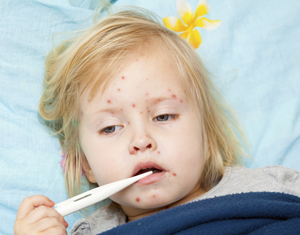 So far, 2015 isn’t getting off to the healthiest start. In addition to a particularly nasty flu season, there have been 102 cases of measles in 14 states to date, putting us on track to see the highest number of infections in the U.S. in more than 20 years.
So far, 2015 isn’t getting off to the healthiest start. In addition to a particularly nasty flu season, there have been 102 cases of measles in 14 states to date, putting us on track to see the highest number of infections in the U.S. in more than 20 years.
So how can we protect our kids? Dr. Steven Weisholtz, Chief of Infectious Disease at Englewood Hospital and Medical Center gives us the scoop.
Bergen Mama: Why do you think the number of Measles cases is rising?
Dr. Weisholtz: Although we have successfully controlled measles in this country since the year 2000, there are countries outside the U.S. who have not. The disease gets introduced here from countries where it is much more common, and when that happens at a place like Disneyland, the disease can quickly infect a vulnerable population, particularly children who are not vaccinated. The majority of new cases we are seeing are among those who have never been vaccinated.
Bergen Mama: Is the vaccine effective?
Dr. Weisholtz: Absolutely. Vaccines are highly effective, around 95%. When a child gets the MMR vaccine, he or she gets two different vaccines, one at 18 months of age, and the second between four and five years of age. After the child gets both vaccines, we assume they are fully protected. If your child is not yet vaccinated, speak to your pediatrician about getting the vaccine, and avoid those countries in which measles have the highest rates.
Bergen Mama: What about a family who is planning a trip to a theme park – say one of their children is old enough to have received both vaccines (age 5 or 6) but the other is not (age 2 or 3). Would you cancel the trip?
Dr. Weisholtz: Ordinarily I would say no, but given what is happening right now with the rising rate of infections, I would change that to a yes. Measles is highly infectious, much more than the flu, and droplets can linger on surfaces for hours. You don’t ever have to come in contact with someone to contract the disease.
Bergen Mama: What are the most common symptoms?
Dr. Weisholtz: For the first day or so, the symptoms will look just like a regular cold or flu, though the fever may run higher. Three to four days later, a rash will occur, as well as white Koplik spots inside the mouth. In the beginning, it can be difficult to make the appropriate diagnosis, because it takes a few days for the telltale symptoms to appear.
Bergen Mama: How do you treat measles?
Dr. Weisholtz: Unfortunately, there’s no specific treatment. No anti-viral medications exist for the disease. So, what we do is treat infections with comfort care, including fever-reducing medications, plenty of fluids, and rest.
Bergen Mama: Is measles deadly?
Dr. Weisholtz: Yes, it can be. Young children and the elderly are the most susceptible. A high percentage of those that are infected get admitted to hospitals, so that’s an important consideration as well.
Bergen Mama:If you get measles, how long does it take to get better?
Dr. Weisholtz: Assuming that no complications occur, it can take a week to 10 days for things to improve.





